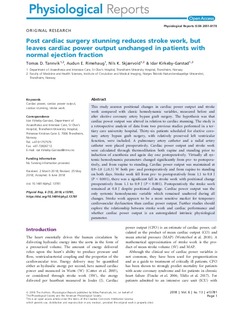| dc.contributor.author | Tannvik, Tomas Dybos | |
| dc.contributor.author | Rimehaug, Audun Eskeland | |
| dc.contributor.author | Skjaervold, Nils Kristian | |
| dc.contributor.author | Kirkeby-Garstad, Idar | |
| dc.date.accessioned | 2018-09-10T13:48:33Z | |
| dc.date.available | 2018-09-10T13:48:33Z | |
| dc.date.created | 2018-06-14T10:06:39Z | |
| dc.date.issued | 2018 | |
| dc.identifier.issn | 2051-817X | |
| dc.identifier.uri | http://hdl.handle.net/11250/2561812 | |
| dc.description.abstract | This study assesses positional changes in cardiac power output and stroke work compared to classic haemodynamic variables, measured before and after elective coronary artery bypass graft surgery. The hypothesis was that cardiac power output was altered in relation to cardiac stunning. The study is a retrospective analysis of data from two previous studies performed in a tertiary care university hospital. Thirty-six patients scheduled for elective coronary artery bypass graft surgery, with relatively preserved left ventricular function, were included. A pulmonary artery catheter and a radial artery catheter were placed preoperatively. Cardiac power output and stroke work were calculated through thermodilution both supine and standing prior to induction of anaesthesia and again day one postoperatively. Virtually all systemic haemodynamic parameters changed significantly from pre- to postoperatively, and from supine to standing. Cardiac power output was maintained at 0.9-1.0 (+/- 0.3) W both pre- and postoperatively and from supine to standing on both days. Stroke work fell from pre- to postoperatively from 1.1 to 0.8 J (p<0.001), there was a significant fall in stroke work with positional change preoperatively from 1.1 to 0.9 J (p<0.001). Postoperatively the stroke work remained at 0.8 J despite positional change. Cardiac power output was the only systemic haemodynamic variable which remained unaltered during all changes. Stroke work appears to be a more sensitive marker for temporary cardiovascular dysfunction than cardiac power output. Further studies should explore the relationship between stroke work and cardiac performance and whether cardiac power output is an autoregulated intrinsic physiological parameter. | nb_NO |
| dc.language.iso | eng | nb_NO |
| dc.publisher | Wiley Open Access | nb_NO |
| dc.rights | Navngivelse 4.0 Internasjonal | * |
| dc.rights.uri | http://creativecommons.org/licenses/by/4.0/deed.no | * |
| dc.title | Post Cardiac Surgery Stunning Reduces Stroke Work, but Leaves Cardiac Power Output Unchanged in Patients with Normal Ejection Fraction | nb_NO |
| dc.type | Journal article | nb_NO |
| dc.type | Peer reviewed | nb_NO |
| dc.description.version | publishedVersion | nb_NO |
| dc.subject.nsi | VDP::Anestesiologi: 765 | nb_NO |
| dc.subject.nsi | VDP::Anaesthesiology: 765 | nb_NO |
| dc.source.volume | 6 | nb_NO |
| dc.source.journal | Physiological Reports | nb_NO |
| dc.source.issue | 13 | nb_NO |
| dc.identifier.doi | 10.14814/phy2.13781 | |
| dc.identifier.cristin | 1591109 | |
| dc.description.localcode | (C) 2018 The Authors. Physiological Reports published by Wiley Periodicals, Inc. on behalf of The Physiological Society and the American Physiological Society. This is an open access article under the terms of the Creative Commons Attribution License, which permits use, distribution and reproduction in any medium, provided the original work is properly cited. | nb_NO |
| cristin.unitcode | 194,65,25,0 | |
| cristin.unitname | Institutt for sirkulasjon og bildediagnostikk | |
| cristin.ispublished | true | |
| cristin.fulltext | original | |
| cristin.qualitycode | 1 | |

